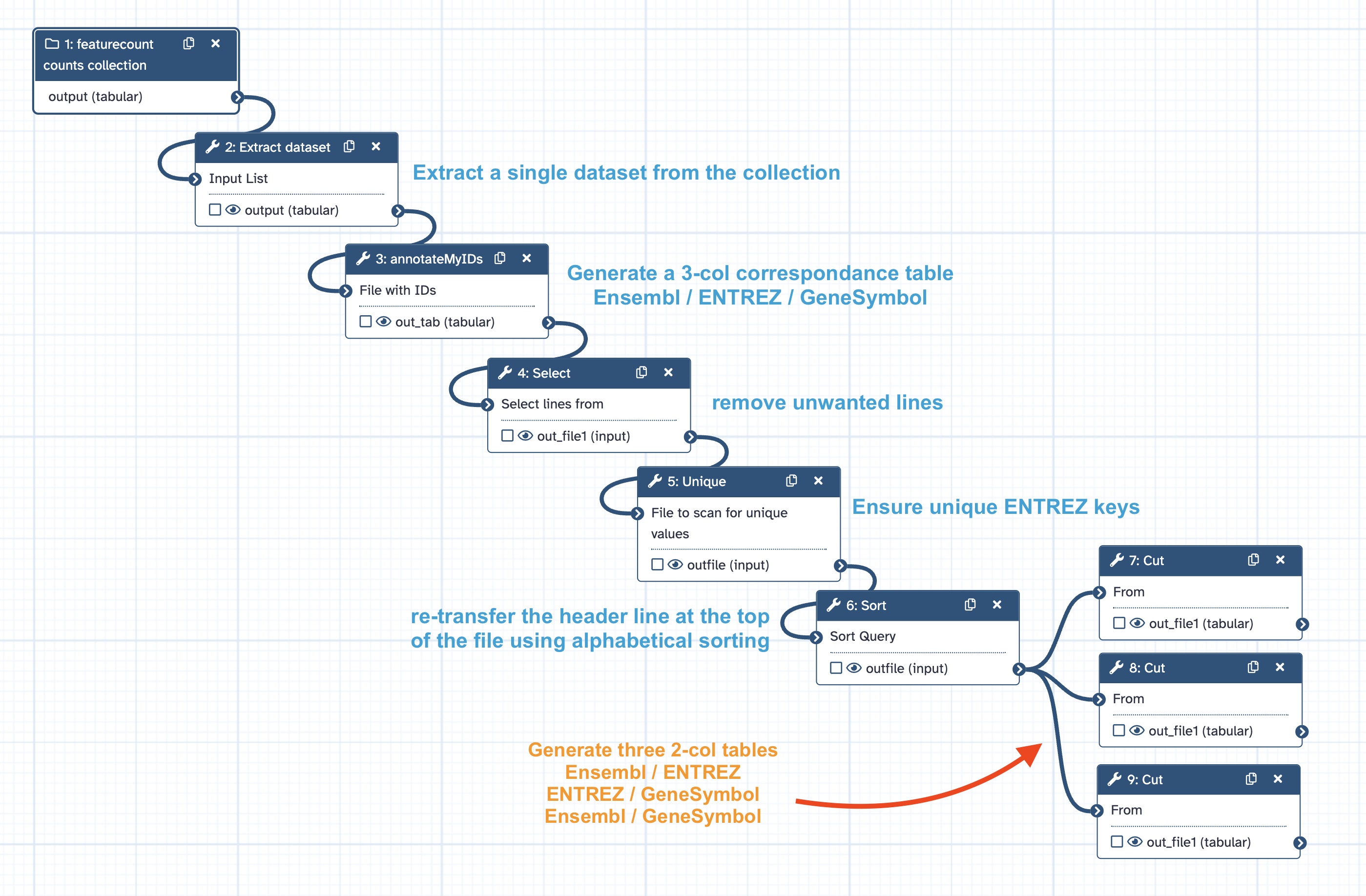Introduction to week-6 exercises¶
Using previous results obtained in the course of PRJNA630433 analysis, we are going to perform successively a fGSEA (fast preranked Gene Set Enrichment Analysis) and an EGSEA (Ensemble of Gene Set Enrichment Analyses) with the corresponding Galaxy tools.
Since this is the last week in the program where we run galaxy tools, we are also going to upgrade the way we use Galaxy, making it "workflow-oriented". Thus Instead of describing each galaxy tool run and showing you the details of the tool forms, we will provide a global description of Workflows (inputs, outputs, purpose of the pipeline of steps) and, most importantly, the corresponding workflow file as well as a screenshot of this file in the Galaxy Workflow Editor.
Tables of correspondances between Ensembl, ENTREZ and Gene Symbol IDs.¶
For both fGSEA and EGSEA, we will some computation steps require tables to convert Ensembl to ENTREZ IDs, ENTREZ to Gene Symbol IDs or Ensembl to Gene Symbol IDs.
This is a perfect occasion to use the new training method described above.
Thus, we are going to use a Galaxy workflow that generates these three tables.
The input material will be a collection of featurecounts tables that we previously
generates in the PRJNA630433 FeatureCounts Counting on HISAT2 bam alignments history.
Thus, to begin, copy the dataset Dc FeatureCounts counts from this history to a new
history which you will name Conversion Tables. This is all we need as an input in this
history. The rest of dataset will be programmatically generated by a galaxy workflow
Ensembl-Entrez-GeneSymbol tables that
- Extracts a dataset from the input data collection.
- Uses the first column of this dataset (the Ensembl gene identifiers of the PRJNA630433)
with the
annotate my IDstool to generate at three-columns dataset, with EnsemblIDs, ENTREZIDs (NCBI's nomenclature, raw numbers) and GeneSymbol IDs, respectively. - Filters out irrelevant lines (improper matchs) with
NAor withRikcontaining Gene Symbols (these genes were identified in the course of the Riken project and are not considered as supported by enough evidence to be included in GSEA) - Ensures that each ENTREZ IDs in the table are unique
- Ensures that the final clean table has a first line header (the previous
uniquestep reorder the lines in an unpredictable way) - Generates three tables by cutting the final 3-col table with c1,c2, c1,c3, and c1,c3, respectively and renames these tables accordingly to their content.
The Ensembl-Entrez-GeneSymbol tables workflow¶
The workflow is available in a Galaxy/json format (.ga) here
There is several ways to use it:
- Download the file and reupload it as a new workflow using the workflow menu.
- These workflow exists already in the server artbio.snv.jussieu.fr and was shared
with you. Thus, it is already visible in your workflow list (workflow menu), and you can
run it as is. However
, to better visualize this workflow you need to
copyit in your account. When this operation is done, new menu items are available for this workflow, includinedit - Finally, you can upload a workflow in your account using its URL. For instance, if
you click the
Importbutton in your workflow list (workflow menu), you can paste the URL of this workflow in this course, and get it imported in you workflow list right away.
The graphical view of the workflow is the following. We have annotated this view but within the Galaxy workflow editor, just click on each step of the workflow to see the details and parameters (right hand part of the editor) used by the tool in this workflow.

RUN the Ensembl-Entrez-GeneSymbol tables workflow¶
- Be sure you are in the right history
Ensembl-Entrez-GeneSymbol tables - Go to the workflow menu and click on the run icon of the workflow
Ensembl-Entrez-GeneSymbol tables - Ensure the appropriate input in select for the workflow (here there is only one dataset in the history, no risk of error !)
- Click the
Run Workflowbutton.
When the workflow has run you'll see that the three last dataset, appropriately named are the one we expected. You can use these datasets latter when needed.
